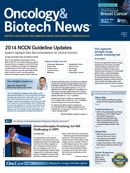Publication
Article
Oncology & Biotech News
NCCN Guidelines Are Effective, but Must Address Cost and Prognostic Stratification
The National Comprehensive Cancer Network (NCCN) guidelines have been a very valuable resource for practicing oncologists for 15 years.
Andre Goy, MD
Editor-in-Chief of
Oncology & Biotech News
Chairman and Director Lymphoma Division Chief John Theurer Cancer Center at HackensackUMC Chief Science Officer and Director of Research and Innovation Regional Cancer Care Associates Professor of Medicine, Georgetown University
The National Comprehensive Cancer Network (NCCN) guidelines have been a very valuable resource for practicing oncologists for 15 years. These guidelines are based on recommendations of expert faculty panels for each subspecialty, and are being updated regularly based on newly published practice-changing data. They are intended primarily to summarize scientific evidence, formulate best practice recommendations, and reduce variations in care.
Public and private health insurers commonly use these guidelines and compendia to support reimbursement decisions. What is unclear, however, is the actual proportion of physicians who follow these evidence-based cancer treatment algorithms.
The decision for a particular patient is indeed complex and multifactorial—from comorbidities, to convenience factors (eg, travel distance, oral vs infusion), to insurance issues. Looking at the NCCN database or other longitudinal studies, such as the National LymphoCare study, it appears striking how patterns of care remain heterogeneous across the board. This has implications for population studies, finding historical controls for comparison, and potentially affects the ability to enroll patients on clinical trials. Though the NCCN guidelines represent a great effort to streamline patterns of care in oncology, they typically offer a range of options that are considered acceptable for each cancer and episode of care. On the other hand, they do not incorporate nonclinical factors, such as treatment cost, expected patient out-of-pocket financial burden, or cost effectiveness, into the guidelines development process. The rapidly rising cost of cancer care is not sustainable, with an estimated price tag of $128 billion in 2014 and current projections of a 46% increase in cancer incidence over the next 20 years. In addition, a huge portion of the money spent in cancer is in the form of empiric palliative care during the last few months of a patient’s life.
Unfortunately, patients and physicians often have very little advanced knowledge about copayments for chemotherapeutics or supportive medications, which might vary among states and carriers. Further, many US oncologists are unaware of the varying total costs associated with one chemotherapy regimen versus another.
For each tumor type and phase of care, there are several options available within the NCCN guidelines deemed acceptable, as they provide similar clinical benefit. However, the treatment options can vary widely in terms of cost. Some analyses have shown a cost variation for 6 months of therapy ranging from under $1,000.00 to more than $57,000.00 for the same reported median overall survival! Moving forward, the incorporation of cost information into guideline development will help increase awareness of the economic implications of routine clinical decision making and reduce the financial burden of cancer treatment on patients and society. Choosing the best option for a patient with cost in mind will definitely become part of the responsibility of caregivers.
On the other hand, we need to make sure that by factoring in cost, we do not compromise patient outcomes. Measuring the outcome for every episode of care is the answer and outcomes should be monitored collectively for optimum results. This would also help categorize—based on priority and success—the many options that have accumulated over time as part of the NCCN guidelines. Finally, the NCCN guidelines do not address in detail the prognostic stratification of patients. Integrating methods to stratify patients based on the ultimate— and evolving—clinical and molecular relevant prognostic markers would certainly help refine oncology treatment algorithms into reliable evidence-based medicine recommendations.
The development of more rationale therapeutics will translate into clinical benefit and improve drug development by focusing on more homogeneous subsets of patients. Oncology is undergoing unprecedented changes with more than 3800 new drugs in the pipeline (mostly targeted therapies) and a growing understanding of and access to the molecular diversity of cancer (the expanding role of molecular diagnostics).
The NCCN guidelines were a first step toward reasoning care in oncology. We now need to embrace the rapid ongoing changes as we evolve toward rationalizing care instead of rationed care. We owe this to our field, our patients, and our society.










